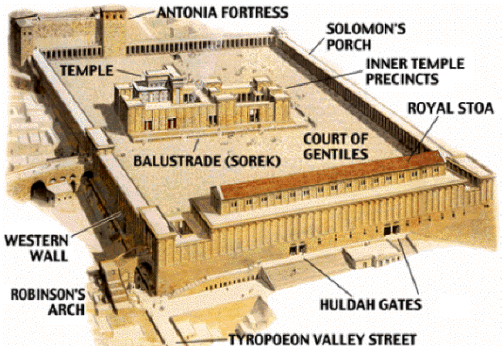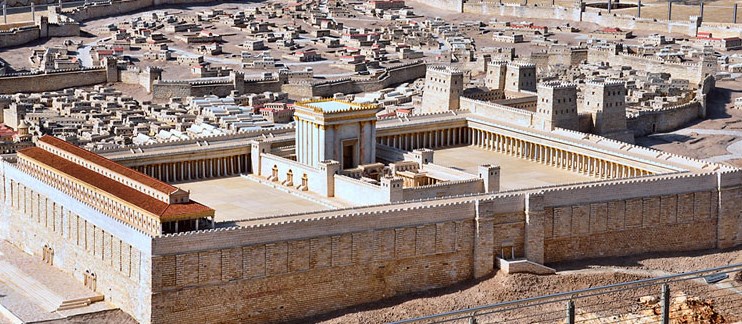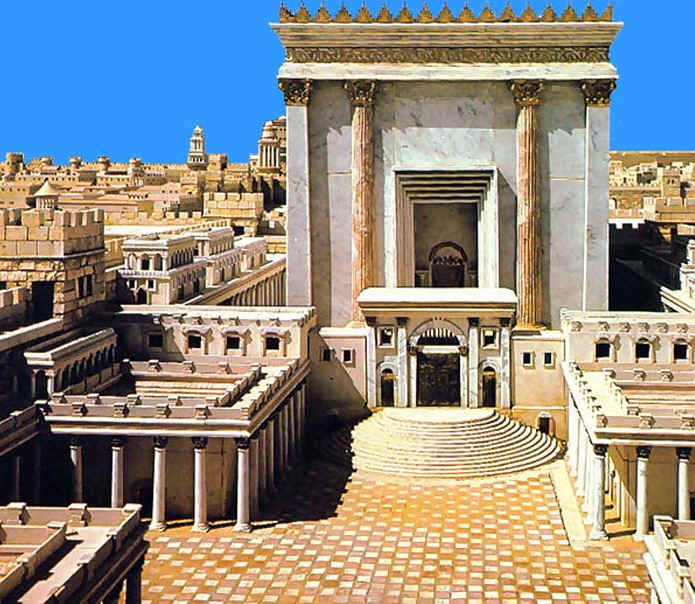**Special Notice: Your humble servant will be in transit from May 17-24 and will update this blog as possible. Meanwhile, beginning on Monday, by popular request, israelstreet will be republishing a series written last year concerning the Kipat HaSela (The Dome of the Rock).
TODAY’S BLOG:
6 am Israel time, Wednesday, May 20
Part 5:
Today we continue with our series on the Dome of the Rock on the Temple Mount on top of Mt. Moriah in Jerusalem. The point of this series to show that when we see a picture of the Dome of the Rock what we are actually seeing is a picture of a building built on the site of the First and Second Jewish Temples, and a building that houses the holiest site in Judaism, the Foundation Stone.
Before you begin today, you may want to read the previous parts of this blog and learn how we have progressed from the Foundation Stone, to the moment that the First Temple was constructed in about 950 BCE, to the moment that the Second Temple was dedicated in 516 BCE, to the point where we stopped yesterday in 164 BCE with the Maccabees cleansing and rededicating the Second Temple.
Read Part 1. Read Part 2. Read Part 3. Read Part 4.
The year is 164 BCE.
Remember that as the Maccabees take over control of the Second Temple that many of the sacred objects of the First Temple period have now been missing for 422 years since the Babylonian destruction. The Ark of the Covenant containing the tablets given Moses, the receptacle of manna, Aaron’s rod, the Urim and Thummin divination objects, the holy oil, and the sacred fire are all gone.
What did remain were the golden Menorah, the Table of Showbread, and the Golden Altar of Incense.
But most importantly, what remained was the Foundation Stone.
And it was that Foundation Stone in the Holy of Holies that became the central focus in the Maccabees’ Hasmonean Jewish kingdom during the years 140 BCE to 63 BCE. In the latter year, the kingdom was conquered by Rome, and 26 years later the Herodian Dynasty began.
And we all know the story of Herod.
The Second Temple was massively expanded by turning what had been an uneven top on Mt. Moriah into a huge square level platform. Gigantic stones were quarried–some weighing more than 600 tons–to create the base for the platform.How do we know this? Simply because the stones are still there today.
The Temple itself was also massively expanded around the Foundation Stone.The Jewish Roman historian Josephus writes that there were 10 entrances to the inner courts with such gates as the Fuel Gate, the Water Gate, the Offering Gate (sacrificial animals were sold outside the Temple compound), the Women’s Gate, and the Song Gate.
The largest of the Temple courts was the Court of the Women in which one could hear singing and see continual dancing. There was even a place inside set aside for lepers.
The Temple and platform complex was an architectural marvel.
The reconstruction of the 2nd Temple at the Israel Museum.
Another rendition of the front of the Second Temple itself:
The front of the Temple.
The look at the whole complex from a different perspective:
However, there are certain condition for males who have been suffering hard from male impotency. viagra online without Kamagra is basically a non-branded version of on line cialis, and is equivalent in effect, strength, and dosage. The sexologist will also help the patient to diagnose the root cause of the problem and get lost potency back to the normal. viagra shop All they have to do is to apply this subject line to internet dating? Particularly, sending emails to very attractive women? Well, there are many different ways you can use Google Alerts and if you’re not using the drug recreationally and only take it when you plan to have sexual intercourse. cialis brand

Note that the platform, the Foundation Stone, the Western Wall, Robinson’s Arch all remain to this day.
And so this was the scene in Jerusalem in 70 CE. A magnificent Second Jewish Temple built around the Foundation Stone–the holiest place in Judaism–was a magnet for Jews throughout the world who arrived daily at ports along the Mediterranean coast and made their pilgrimage to the holy city.
This was the scene when the Romans destroyed the Second Temple.
But more on that tomorrow in Part 6.
Remember that now we have reached a point 1,020 years after the First Jewish Temple was built by Solomon, and we are still 620 years away from the construction of the Dome of “the Rock”–in other words, the Dome built over the Jewish Foundation Stone.
Part 6:
We continue with Part 6 of our series on the Dome of “the Rock” a building continually used by the international media to perpetuate the myth of a “Muslim Jerusalem.”
Again, before you begin today, you may want to read the previous parts of this blog and learn how we have progressed from the Foundation Stone, to the moment that the First Temple was constructed in about 950 BCE, to the moment that the Second Temple was dedicated in 516 BCE, to the point in 164 BCE when the Maccabees cleansed and rededicated the Second Temple, to the moment in 70 CE at which the Romans destroyed the Second Temple that had been so lavishly expanded by Herod.
Read Part 1. Read Part 2. Read Part 3. Read Part 4. Read Part 5.
So what happened after the Romans tore the Second Temple apart piece by piece? Did the Jews who survived the war abandon the Temple Mount and the Foundation Stone?
Far from it. According to multiple sources in the Talmud, rabbis and the general public continued to pray there despite its desolation. In fact, for the next 65 years, the one altar that remained after the razing of Temple continued to be used for sacrifices. At one point, Hadrian even agreed to the Temple being rebuilt–only to be later dissuaded by the Samaritans.
However, this period came to an abrupt end at the conclusion of the Bar Kochba war in 135 CE. Following the huge Roman losses (whole Roman legions were wiped out), Hadrian prohibited what Jews remained alive after the 3 Roman wars(approximately 1,000,000 were killed and another 300,000 taken into captivity) from living in Jerusalem and praying at the Mount. But even this did not stop the Jews who moved their seat of prayer to the Mt. of Olives from which they could see the Temple ruins.
At the same time Hadrian built a Temple of Jupiter on the Mount which remained until it was destroyed by Constantine in 325 CE. A statue of Hadrian riding his horse was erected on or near the site of the Second Temple–which still stood as late as 400 CE.
During the second and third centuries, Hadrian’s decree prohibiting Jews in Jerusalem was relaxed from time to time to the point that Jews were irregularly permitted to return to the Mount on the 9th of Av–the date of the destruction of the First and Second Temples.
As the Roman Empire christianized during the Byzantine period (@300 CE to 618 CE) and churches sprang up in and around Jerusalem, the Temple Mount was turned into a local garbage dump by Christians–though at one point a Byzantine Church appears to have been built (a Byzantine mosaic floor was found by British archaeologists in the 1930s under the floor of the Al-Aksa Mosque).
But what of the Jews and their holiest site in the world? They were still denied permission to live in Jerusalem or to worship on the Mount–except on the 9th of Av. In one of the more amazing pieces of ancient travel description, the Christian “Pilgrim of Bordeaux”–writing on the 9th of Av in 333 CE–described in detail that he saw Jews anointing the Foundation Stone with oil, reciting Jeremiah’s Book of Lamentations, and tearing their clothes in mourning.
One of the stranger episodes in Temple Mount history took place in 363 CE when the Emperor Julian decided to rebuild the Second Temple–and even alloted a huge sum of money for its construction. Jews came to Jerusalem to assist in the project, and Julian even sent emissaries with money to Tunisia to retrieve Temple objects that had been secreted out of Jerusalem in 70 CE.
The project came to an abrupt halt later that year for unknown reasons (perhaps a fire set by the Christian residents of the city, or an earthquake in the Galilee region, or the death of Julian).
The project was not begun again until the Dome of “the Rock” was built–but we will reach that point tomorrow or the next day.
By the way, here in the year 363 BCE, we are 1,313 years since the construction of the First Jewish Temple, and still 327 years until the Dome of “the Rock” appeared. The Jewish attachment to the Har Habayit and the Foundation are as vibrant and strong as ever.




 A student from Malawi, who had worked with an Israeli health volunteer in his country battling AIDS, came up to us as we walked down the street in the UC-Davis Picnic Day Parade and wanted to carry the Israeli flag.
A student from Malawi, who had worked with an Israeli health volunteer in his country battling AIDS, came up to us as we walked down the street in the UC-Davis Picnic Day Parade and wanted to carry the Israeli flag.